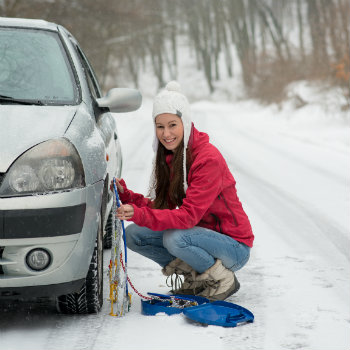
VroomVroomVroom can not only make sure you have a great rental car for your trip at the best possible price; we also ensure you are equipped to handle any hazards you may come across on your drive. Here are our winter driving tips for New Zealand:
As an oceanic country, the weather can change suddenly. If you are heading to the mountains, it is best to check the weather forecast and highway conditions before you get on the road. For weather, try MetService for the most comprehensive weather forecasting available. You can download their app, or use their 0900 phone service for local forecasts, whichever technology works best for you at the time. For the South Island, you can call 0900 999 03 and it could cost around $1.99. For highway conditions, call their 24/7 freephone number 0800 4 HIGHWAYS (0800 44 44 49) or check out the live traffic cameras at NZ Transport Agency.

You most certainly will. Please note that the rental car company can supply chains and will be happy to show you how to fit them. Note that chains must be installed on the drive wheels. If you need help in coordinating with the provider, feel free to contact our customer care experts. Make sure you also carry gloves and a torch; there's every chance you'll be putting them on in dull light. Further, always keep your phone handy and charged.
Black ice is a thin sheet of ice, dark in appearance and difficult for drivers to see. It is commonly found on frosty mornings around lakes and waterways, as well as in bridges, intersections, highway overpasses and underpasses. Warning signs are displayed when black ice conditions are prevalent, but you need to be vigilant at any time, especially in shady places. Remember that ice is much worse than wet roads, hence all drivers are advised to stay alert and take extra precautions when driving.
Generally speaking, snowfall shouldn't change your plans for long on the main highways and byways. The issues will be if you are planning to cross the mountain passes over the Southern Alps. Having up-to-date information is vital, as the passes may close for longer periods of time. The two most commonly travelled on tourist itineraries are Arthur's Pass on State Highway 73, along the route between Christchurch and the West Coast, and Lindis Pass traversed by State Highway 8, linking the Mackenzie Basin to Central Otago.
Driving conditions in South Island especially during winter (May to September) can be very challenging. Please take note of the following information.

Remember that you can't always travel along at 100 kilometres per hour. This is especially true in winter, when there is more potential for disruption. Allow plenty of extra time, especially if you are travelling to a time specific activity. After all, you're on holiday! It's important to be able to pull over for those photo opportunities.
If driving conditions are daunting and you think you may be holding others up, pull over and let them pass. Likewise, if the weather forecast is truly awful, don't try to drive. Adjust your plans and stay put. Sometimes spontaneity means you'll uncover a treasure you would have missed if you'd stuck doggedly to your planned itinerary. It's a good idea to drive with your headlights on at all times, day and night.